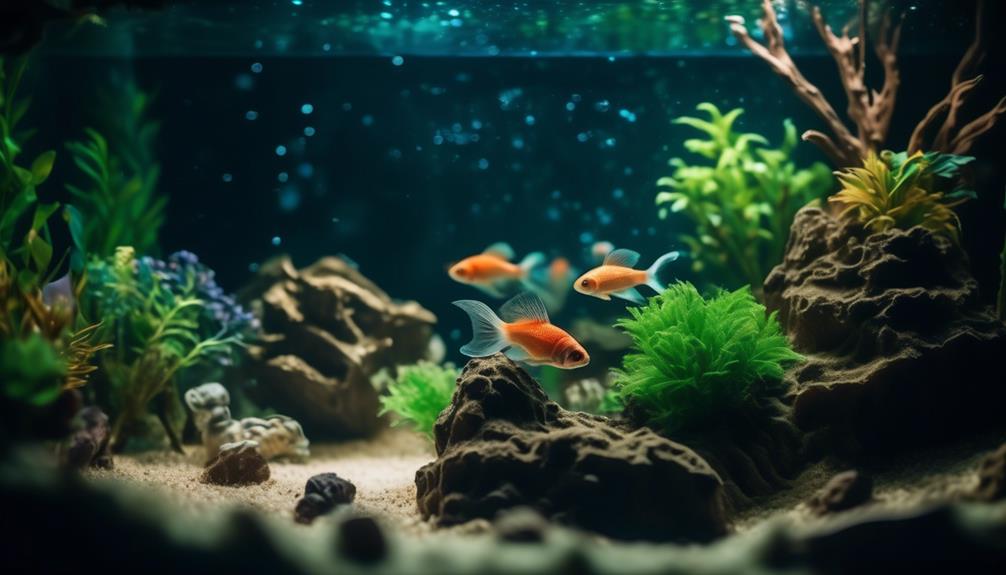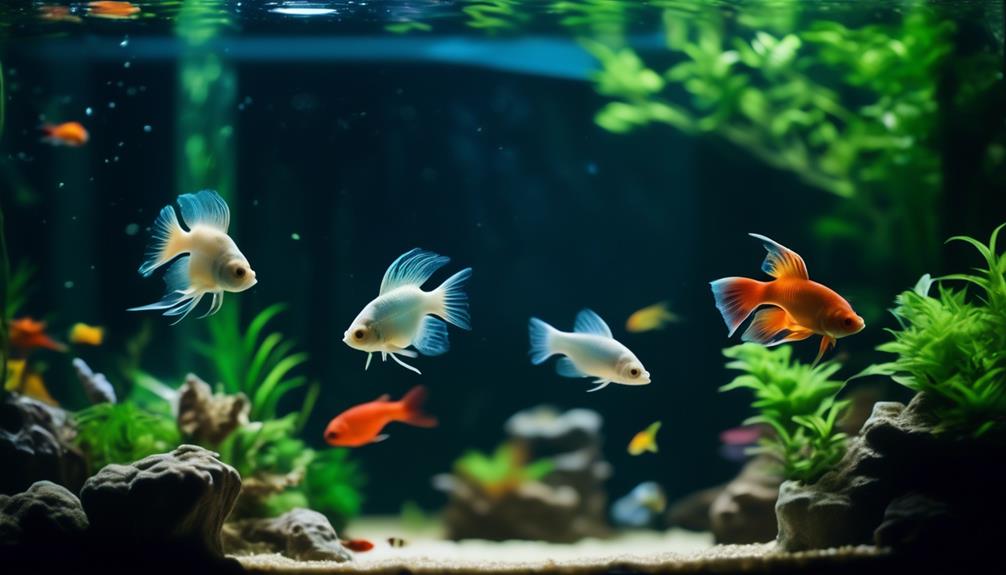Welcome to the world of Molly fish, where their vibrant colors and unique patterns make them a captivating addition to any aquarium.
In this comprehensive guide, we will explore the ins and outs of Molly fish care and breeding, providing you with the knowledge needed to ensure their optimal well-being.
From understanding their habitat and water requirements to setting up the perfect environment and providing a balanced diet, we will cover it all.
But that's not all – we'll also delve into the fascinating world of Molly fish breeding, offering valuable insights and tips for success.
So, if you're ready to embark on a journey into the realm of Molly fish care and breeding, then join us as we unlock the secrets to their thriving existence.
Key Takeaways
- Molly fish thrive in brackish water conditions, so it's important to ensure the water parameters are suitable for their health and well-being.
- Setting up a spacious aquarium with a minimum of 20 gallons is recommended, along with maintaining a higher temperature of 75-80°F.
- Proper feeding is crucial for mollies, as they are omnivores and require a balanced diet of proteins and vegetables. Overfeeding can lead to excessive waste production.
- When breeding mollies, it's essential to provide hiding spots and dense aquarium plants to protect the fry from being eaten by adult mollies. Livebearer fry are larger and can consume crushed flakes and brine shrimp.
Molly Fish Habitat and Characteristics
Molly fish are adaptable creatures, capable of thriving in a wide range of freshwater, brackish, and even saltwater habitats. Their behavior is influenced by their environment, and understanding their behavior is crucial for successful breeding.
Molly fish exhibit various behaviors, including shoaling, where they form social groups, and aggression, particularly among males competing for females.
When it comes to breeding behavior, molly fish are livebearers, meaning they give birth to live young rather than laying eggs. Male mollies have a specialized fin called a gonopodium, which is used to transfer sperm to the female during mating.
After mating, the female carries the fertilized eggs inside her until they hatch. It is important to provide dense aquarium plants as hiding spots for the fry, as adult mollies may predate on their own young.
Understanding molly fish behavior and breeding behavior is essential for successfully caring for and breeding these fascinating creatures.
Water Requirements for Mollies
Understanding the specific water requirements is crucial for successfully caring for and breeding molly fish. When it comes to molly fish breeding methods, it is important to provide the right water conditions to ensure the health and well-being of these fish. Common diseases in mollies can often be linked to improper water parameters.
Changes in water parameters can cause kidney problems, while soft tap water lacking minerals can lead to diseases. To prevent these issues, it is recommended to add Wonder Shells or Seachem Equilibrium to the tank to provide necessary minerals. Mollies prefer higher pH, KH, and GH levels in the aquarium.
Setting Up an Aquarium for Mollies

To create an optimal environment for molly fish, careful consideration must be given to setting up the aquarium. Here are three important factors to consider:
- Tank Size: It is recommended to have at least a 20-gallon tank for mollies, but larger tanks are necessary for bigger species. Mollies are active swimmers and need space to move around comfortably.
- Aquarium Decoration Ideas: Adding plants and hiding spots in the aquarium is crucial for mollies. Dense aquarium plants, such as Java Fern or Amazon Sword, provide hiding places for fry and help to create a natural environment. Adding driftwood or rocks can also enhance the aesthetic appeal of the tank.
- Tank Mates for Mollies: Mollies are compatible with many community fish that live in similar water conditions. Good tank mates for mollies include guppies, platies, swordtails, and tetras. However, mollies may nibble on slow-moving, long-finned fish, so it's important to choose tank mates wisely.
Molly Fish Diet and Feeding Tips
A well-balanced diet is essential for the health and vitality of molly fish, ensuring their nutritional needs are met for optimal growth and development. As omnivores, molly fish require a mix of proteins and vegetables in their diet. High-quality flakes, pellets, frozen foods, and gel food can be provided to meet their dietary requirements.
It is important to avoid overfeeding, as indicated by long strings of poop, which can lead to health issues. Scatter the food to allow other fish in the tank, including molly fish tank mates, to have access to the food.
Additionally, it is worth noting that different color variations of molly fish may have specific dietary requirements, so it is crucial to research and cater to their unique needs.
Breeding Mollies: Tips and Guidelines

Breeding mollies requires careful attention to specific guidelines and techniques in order to ensure successful reproduction and the survival of the fry. Here are three important tips to consider when breeding mollies:
1) Tank Setup: Create a suitable environment for breeding by providing dense aquarium plants, such as Java moss or hornwort, as hiding spots for the fry. This will help protect them from predation by adult mollies. Additionally, maintaining optimal water conditions, including temperature (around 75-80°F), pH, and salinity levels, is crucial for successful breeding.
2) Selecting Mating Pairs: Choose healthy adult mollies, preferably one male for every two to three females, to ensure a balanced breeding ratio and prevent constant attention from males. When selecting mating pairs, consider the desired traits, such as color or fin shape, to enhance the offspring's quality.
3) Separating Adult Mollies from Fry: After breeding, it's vital to separate adult mollies from fry to prevent predation. Use a separate breeding tank or a breeding net within the main tank to keep the fry safe. It's important to note that adult mollies may prey on their own young, so providing hiding spots for the fry is essential.
Frequently Asked Questions
How Long Do Mollies Typically Live?
Mollies typically live for 2-5 years, depending on various factors such as water quality, diet, and genetics. To ensure the best lifespan, it is important to provide proper care, a balanced diet, and create suitable conditions for breeding.
Can Mollies Be Kept in a Freshwater-Only Aquarium?
Freshwater molly care offers numerous benefits for aquarium enthusiasts. By providing a suitable environment with proper water parameters, mollies can thrive in a freshwater-only aquarium, making them an ideal choice for those seeking vibrant and low-maintenance fish.
Are There Any Specific Tank Mates That Should Be Avoided When Keeping Mollies?
When keeping mollies, it is important to avoid tank mates with slow-moving, long-finned fish that may be nibbled on. Additionally, aggressive or fin-nipping species should be avoided to ensure the well-being of mollies.
How Often Should the Water in a Molly Aquarium Be Tested and Maintained?
Regular testing and maintenance of water in a molly aquarium is crucial to ensure ideal water conditions. Testing frequency depends on various factors such as tank size, stocking levels, and filtration system. It is recommended to test water parameters at least once a week to monitor pH, ammonia, nitrite, and nitrate levels. This helps to identify any fluctuations or potential issues and allows for timely adjustments or interventions to maintain a healthy environment for the mollies.
What Are Some Common Diseases or Health Issues That Mollies Are Prone To?
Preventing and treating common molly fish diseases is crucial for maintaining optimal molly fish health. Regular water testing, maintaining proper water parameters, providing a balanced diet, and quarantining new fish can help mitigate risks and ensure a healthy aquarium environment.
Conclusion
In conclusion, 'Molly Fish: The Ultimate Guide to Care and Breeding' provides a comprehensive and detailed overview of Molly fish. It covers their habitat, water requirements, aquarium setup, diet, and breeding. This informative resource equips readers with the necessary knowledge to ensure the optimal care and successful breeding of Molly fish.
With the insights provided, readers can dive into the world of Molly fish keeping with confidence. They can create a vibrant and thriving aquarium for their fish. As the saying goes, 'A little knowledge goes a long way' in the world of Molly fish care and breeding.

